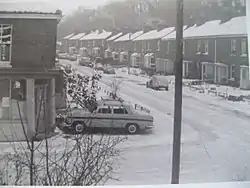Argyle Street, Norwich
Argyle Street was a Victorian terraced street in Norwich, Norfolk. It became a squat lasting from 1979 to 1985. The street was then demolished in 1986. Some of the newbuild houses were subsequently demolished in 2015.
| Argyle Street Alternative Republic | |
 Argyle Street, in Winter 1981 | |
 Location within Norwich | |
| Maintained by | Norwich City Council |
|---|---|
| Coordinates | 52°37′18.9″N 1°18′10.7″E |
| Construction | |
| Completion | 1873 |
| Demolished | 1986 |
| Other | |
| Known for | Squats in the 1980s |
History
A Victorian street consisting of small two up two down terraced houses, according to Morant's map, Argyle Street was partly built in 1873.[1] In 1883-4 there were 106 families, mainly manual workers with a significant number of men employed by the railway.[2] The Jarrold & Sons Directory of 1889 lists one shopkeeper.[3]
The street was saved from slum clearance in the early 1960s, after the nearby area of Richmond, or the village on the hill was completely demolished.[4]
Squatted
The University of East Anglia planned to buy the Victorian terraced housing of Argyle Street from Norwich City Council for student homes in 1979. However, on 6 December 1978 40 squatters moved into 14 empty houses and one of Britain's longest-running and biggest squats had begun. The other 15 empty houses were quickly occupied and eventually the street had 120 squatters. [5][4]
The squatters called their street the Argyle Street Alternative Republic.[5] The lamp posts were painted to look like giraffes and the pavements were embellished with rainbows and peace signs.[6]
In 1980 the squatters formed a co-operative which was backed by Norwich City Council, which at the time included Pat Hollis. Together they applied for a grant from the Government-funded Housing Corporation. In 1981 a £1 million grant was agreed for a major renovation scheme, but in 1982 the Department of the Environment blocked Norwich City Council's plan to sell or lease the houses to the co-operative.[7]
Redevelopment
In 1984 Norwich City Council decided to demolish the area and develop it for sheltered homes. The final eviction of squatters from Argyle Street occurred in February 1985.[7]
Some of the redeveloped houses, built in 1986, were judged to be at risk of subsidence in 2009. The tenants were evacuated and the buildings were finally demolished in 2015 after standing empty for 6 years and becoming an eyesore. The only option left to the Council was to demolish the homes for £230,000 and then to make a park.[8]
Film
In 1981, Argyle Street became the setting for scenes of a filmed adaptation of Doris Lessing's dystopian novel Memoirs of a Survivor.[9]
In 1985, Al Stokes made a film about the eviction of the squatters, called Street of Experience.[5] Stokes and his crew filmed the leaving party on the night of February 19 and the eviction the following day.[10]
References
- "Two copies of the map of the City of Norwich by A. W. Morant, City surveyor, printed". National Archives. Retrieved 24 April 2019.
- Eyre Brothers (1883). Norwich Directory. Norwich.
- Jarrold & Sons (1889). Directory of the City of Norwich. Norwich.
- "The Beginning". Norch. Retrieved 24 April 2019.
- Freezer, David (7 October 2011). "Banned squatters' film is to be shown in Norwich at last". Norwich Evening News. Retrieved 24 April 2019.
- "Photo gallery: Remembering 30 years since the end of the Argyle Street Alternative Republic". Eastern Daily Press. 20 February 2016. Retrieved 24 April 2019.
- Stokes, Al (2012). "A Brief History of Argyle Street". Retrieved 24 April 2019.
- Grimmer, Dan (24 October 2015). "Eyesore Norwich homes finally set for demolition after standing empty for more than five years". Eastern Daily Press. Retrieved 24 April 2019.
- http://www.festival-cannes.com/en/archives/ficheFilm/id/1766/year/1981.html
- "Video: The final hours of Norwich's Argyle Street Alternative Republic". Eastern Daily Press. 21 February 2015. Retrieved 24 April 2019.
